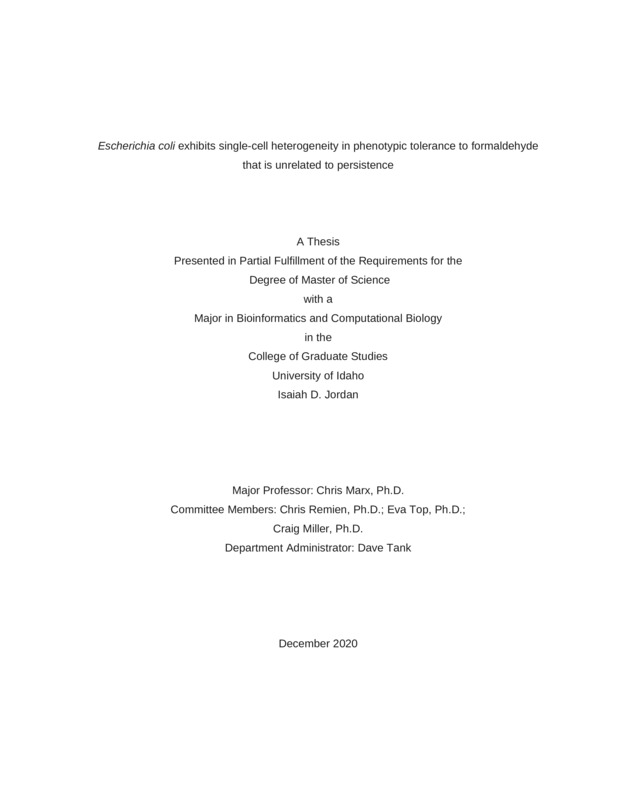Escherichia coli exhibits single-cell heterogeneity in phenotypic tolerance to formaldehyde that is unrelated to persistence
Jordan, Isaiah. (2020-12). Escherichia coli exhibits single-cell heterogeneity in phenotypic tolerance to formaldehyde that is unrelated to persistence. Theses and Dissertations Collection, University of Idaho Library Digital Collections. https://www.lib.uidaho.edu/digital/etd/items/jordan_idaho_0089n_12024.html
- Title:
- Escherichia coli exhibits single-cell heterogeneity in phenotypic tolerance to formaldehyde that is unrelated to persistence
- Author:
- Jordan, Isaiah
- Date:
- 2020-12
- Keywords:
- E. coli Oxidative stress Persisters Phenotypic heterogeneity
- Program:
- Biology
- Subject Category:
- Microbiology
- Abstract:
-
The phenomenon of phenotypic heterogeneity, where a clonal population expresses varying phenotypes has been reported across a wide variety of organisms, and many of an organism’s traits may exhibit this heterogeneity. Heterogeneity is often phyisologically relevant, allowing the clonal population to divide the labor of metabolic (or other) tasks, or to maintain more resilient subpopulations that can survive stressors that kill the bulk of the population. Recently, it was discovered that Methylorubrum extorquens, a facultative methylotroph, possesses heterogeneity in tolerance to formaldehyde, a toxin produced by M. extorquens during growth on methanol. Surprisingly, transcriptomic data indicated that genes responsible for methylotrophy are not responsible for enhanced tolerance to formaldehyde demonstrated by the resistant subpopulation, but rather that more general mechanisms such as protein repair via chaperonins are responsible. This suggested that this heterogeneity may be present even in organisms that do not produce large quantities of formaldehyde during routine metabolism, and thus be widely distributed across bacteria. To investigate this, I tested Escherichia coli for heterogeneity, and compared its survival and growth dynamics to those of M. extorquens. It was determined that E. coli does indeed show heterogeneity to formaldehyde stress, however, there are some major differences in how this heterogeneity affects growth dynamics. It was further hypothesized that due to the nature of some of these differences this tolerance may be the result of persistence, a condition where a viable cell temporarily ceases division, a state that is widely reported to allow the cell to avoid damage from a broad variety of stressors. Experiments determined that this was not the case, however, these same experiments suggested that these persister cells can maintain memory of the environments that they were in during their entrance into a persistent state. This implies that persistence is a form of phenotypic heterogeneity that itself preserves other dimensions of heterogeneity, a concept which to my knowledge has not been previously described.
- Description:
- masters, M.S., Biology -- University of Idaho - College of Graduate Studies, 2020-12
- Major Professor:
- Marx, Chris J
- Committee:
- Remien, Chris; Top, Eva; Miller, Craig
- Defense Date:
- 2020-12
- Identifier:
- Jordan_idaho_0089N_12024
- Type:
- Text
- Format Original:
- Format:
- application/pdf
- Rights:
- In Copyright - Educational Use Permitted. For more information, please contact University of Idaho Library Special Collections and Archives Department at libspec@uidaho.edu.
- Standardized Rights:
- http://rightsstatements.org/vocab/InC-EDU/1.0/

